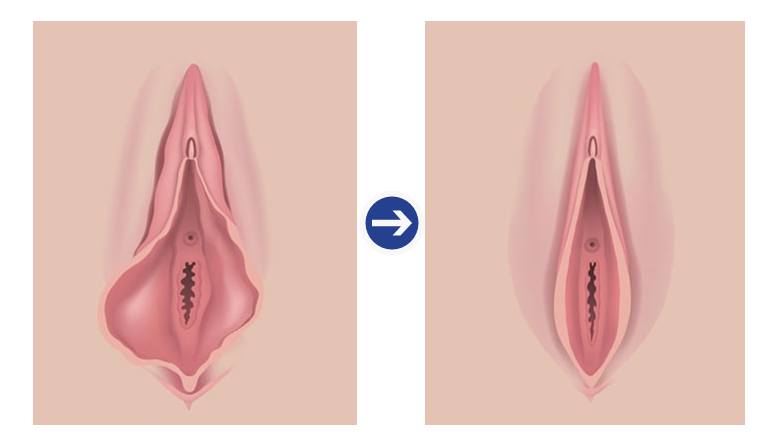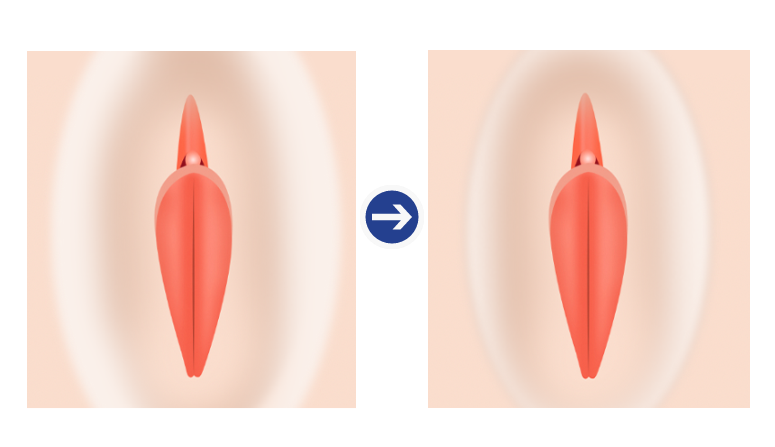Labia Majora Surgery in Korea
Firm up protruding or wrinkled Labia
What is Labia Majora Surgery?
The labia majora are fatty tissues that surround the outer part of the labia minora, protecting the labia minora and clitoris, and acting as a cushion during sexual activity. A normal labia majora typically has a smooth, arch-like shape with firm and plump volume.
However, an addition to congenital factors, the labia majora can become deformed due to external factors such as childbirth, sexual intercourse, hormonal influences, aging, and excessive dieting.
If the labia majora become enlarged and cover the vaginal opening, or if they have many wrinkles or are dark in color, this can cause a loss of self-confidence. In addition, deformation of the labia majora not only affects appearance, but can also cause heath issues such as vaginitis, itchiness, and bad odor, so appropriate treatment is necessary.

Types of Labia Majora Surgery
Labia majora that lack volume are made more voluminous by grafting autologous fat to the labia majora, and loose or hypertrophic labia majora can be reduced through liposuction or excision surgery.

Labia majora enlargement
In cases where the labia majora lack volume, augmentation surgery is performed for functional and cosmetic reasons. The elasticity of the vulva that has been lost due to aging or other causes is restored using surgical methods such as autologous fat grafting, autologous dermal grafting, excision, implant injection, and laser treatment.

Labia majora reduction
In cases of severe wrinkles and sagging labia majora, labia majora that are unevenly developed on both sides, or asymmetrical labia majora, the labia majora are reduced and corrected through liposuction or excision surgery.
Labia Majora surgery process
The surgery is performed in different ways depending on the size and shape of the labia majora.
▪️ Labia Majora Reduction Surgery : Surgery to reduce the protruding area by excising the labia majora
▪️ Labia Majora Lifting Surgery : Surgery to lift and restore elasticity to the labia majora
▪️ Labia Majora Augmentation Surgery : Surgery to graft autologous fat to give natural volume to the labia majora
Surgery Time
Less than 1 hour
Anesthesia
General / Local anesthesia
Hospitalization
Same-day discharge
Stitch Removal
Not needed
Abstinence Period
3 weeks
Who Needs Labia Majora Surgery?
Labia majora surgery is not purely size correction and the removal of wrinkles, but is also performed taking the harmony of the surrounding labia minora and clitoris into consideration. In addition to external improvement of the labia majora, it can also sexual sensation, prevent gynecological diseases, and provide aesthetic satisfaction.

Frequently Asked Questions
What is stem cell hair loss treatment?
Stem cell hair loss treatment involves injecting stem cell cultures into hair follicles where hair loss has occurred, aiding in the regeneration of hair follicle cells and promoting hair growth. This method utilizes the regenerative properties of stem cells to strengthen hair roots and capillaries, leading to increased hair density and thickness.
How does the stem cell hair loss treatment procedure work?
The procedure involves four main steps: extracting fat cells from the patient, separating stem cells from these fat cells, activating the stem cells with natural proteins, and injecting the activated stem cells into the scalp. This process aims to rejuvenate hair follicles and stimulate new hair growth.
Who is an ideal candidate for stem cell hair loss treatment?
Individuals who have recently begun experiencing hair loss are ideal candidates, as early intervention yields the best results. However, even those with significant hair loss can benefit from consistent treatment. If some hair follicles remain, even if they are thin and weak, stem cell therapy can help revive them. For individuals with completely dead hair follicles, results may be less effective.
What are the benefits of stem cell hair loss treatment?
Benefits include increased blood flow to the scalp, regulation of immune responses, prevention of skin aging and hair loss, and improvement of skin texture. The treatment strengthens weakened hair roots and capillaries, leading to the regeneration of new hair and hair follicle cells, resulting in thicker and more numerous hairs.
Are there any side effects associated with stem cell hair loss treatment?
The treatment is generally considered safe, with minimal side effects. Some patients may experience temporary redness or swelling at the injection site, which typically subsides within a few days. As with any medical procedure, it’s important to consult with a qualified healthcare provider to discuss potential risks and benefits.
